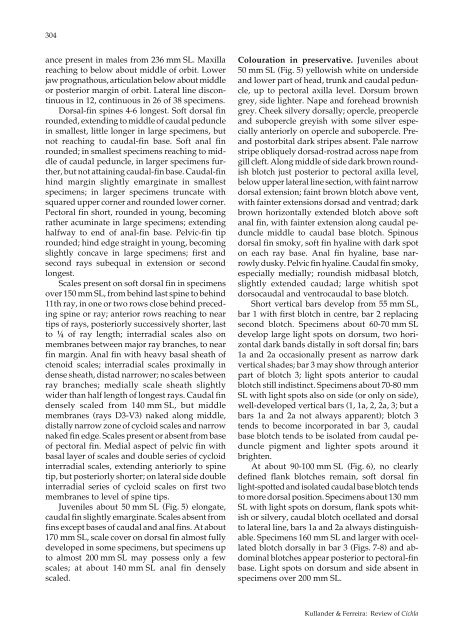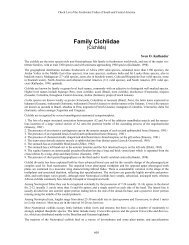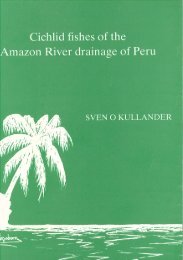Open Access PDF - Sven Kullander
Open Access PDF - Sven Kullander
Open Access PDF - Sven Kullander
Create successful ePaper yourself
Turn your PDF publications into a flip-book with our unique Google optimized e-Paper software.
304<br />
ance present in males from 236 mm SL. Maxilla<br />
reaching to below about middle of orbit. Lower<br />
jaw prognathous, articulation below about middle<br />
or posterior margin of orbit. Lateral line discontinuous<br />
in 12, continuous in 26 of 38 specimens.<br />
Dorsal-fin spines 4-6 longest. Soft dorsal fin<br />
rounded, extending to middle of caudal peduncle<br />
in smallest, little longer in large specimens, but<br />
not reaching to caudal-fin base. Soft anal fin<br />
rounded; in smallest specimens reaching to middle<br />
of caudal peduncle, in larger specimens further,<br />
but not attaining caudal-fin base. Caudal-fin<br />
hind margin slightly emarginate in smallest<br />
specimens; in larger specimens truncate with<br />
squared upper corner and rounded lower corner.<br />
Pectoral fin short, rounded in young, becoming<br />
rather acuminate in large specimens; extending<br />
halfway to end of anal-fin base. Pelvic-fin tip<br />
rounded; hind edge straight in young, becoming<br />
slightly concave in large specimens; first and<br />
second rays subequal in extension or second<br />
longest.<br />
Scales present on soft dorsal fin in specimens<br />
over 150 mm SL, from behind last spine to behind<br />
11th ray, in one or two rows close behind preceding<br />
spine or ray; anterior rows reaching to near<br />
tips of rays, posteriorly successively shorter, last<br />
to ~ of ray length; interradial scales also on<br />
membranes between major ray branches, to near<br />
fin margin. Anal fin with heavy basal sheath of<br />
ctenoid scales; interradial scales proximally in<br />
dense sheath, distad narrower; no scales between<br />
ray branches; medially scale sheath slightly<br />
wider than half length of longest rays. Caudal fin<br />
densely scaled from 140 mm SL, but middle<br />
membranes (rays D3-V3) naked along middle,<br />
distally narrow zone of cycloid scales and narrow<br />
naked fin edge. Scales present or absent from base<br />
of pectoral fin. Medial aspect of pelvic fin with<br />
basal layer of scales and double series of cycloid<br />
interradial scales, extending anteriorly to spine<br />
tip, but posteriorly shorter; on lateral side double<br />
interradial series of cycloid scales on first two<br />
membranes to level of spine tips.<br />
Juveniles about 50 mm SL (Fig. 5) elongate,<br />
caudal fin slightly emarginate. Scales absent from<br />
fins except bases of caudal and anal fins. At about<br />
170 mm SL, scale cover on dorsal fin almost fully<br />
developed in some specimens, but specimens up<br />
to almost 200 mm SL may possess only a few<br />
scales; at about 140 mm SL anal fin densely<br />
scaled.<br />
Colouration in preservative. Juveniles about<br />
50 mm SL (Fig. 5) yellowish white on underside<br />
and lower part of head, trunk and caudal peduncle,<br />
up to pectoral axilla level. Dorsum brown<br />
grey, side lighter. Nape and forehead brownish<br />
grey. Cheek silvery dorsally; opercle, preopercle<br />
and subopercle greyish with some silver especially<br />
anteriorly on opercle and subopercle. Pre-<br />
and postorbital dark stripes absent. Pale narrow<br />
stripe obliquely dorsad-rostrad across nape from<br />
gill cleft. Along middle of side dark brown roundish<br />
blotch just posterior to pectoral axilla level,<br />
below upper lateral line section, with faint narrow<br />
dorsal extension; faint brown blotch above vent,<br />
with fainter extensions dorsad and ventrad; dark<br />
brown horizontally extended blotch above soft<br />
anal fin, with fainter extension along caudal peduncle<br />
middle to caudal base blotch. Spinous<br />
dorsal fin smoky, soft fin hyaline with dark spot<br />
on each ray base. Anal fin hyaline, base narrowly<br />
dusky. Pelvic fin hyaline. Caudal fin smoky,<br />
especially medially; roundish midbasal blotch,<br />
slightly extended caudad; large whitish spot<br />
dorsocaudal and ventrocaudal to base blotch.<br />
Short vertical bars develop from 55 mm SL,<br />
bar 1 with first blotch in centre, bar 2 replacing<br />
second blotch. Specimens about 60-70 mm SL<br />
develop large light spots on dorsum, two horizontal<br />
dark bands distally in soft dorsal fin; bars<br />
1a and 2a occasionally present as narrow dark<br />
vertical shades; bar 3 may show through anterior<br />
part of blotch 3; light spots anterior to caudal<br />
blotch still indistinct. Specimens about 70-80 mm<br />
SL with light spots also on side (or only on side),<br />
well-developed vertical bars (1, 1a, 2, 2a, 3; but a<br />
bars 1a and 2a not always apparent); blotch 3<br />
tends to become incorporated in bar 3, caudal<br />
base blotch tends to be isolated from caudal peduncle<br />
pigment and lighter spots around it<br />
brighten.<br />
At about 90-100 mm SL (Fig. 6), no clearly<br />
defined flank blotches remain, soft dorsal fin<br />
light-spotted and isolated caudal base blotch tends<br />
to more dorsal position. Specimens about 130 mm<br />
SL with light spots on dorsum, flank spots whitish<br />
or silvery, caudal blotch ocellated and dorsal<br />
to lateral line, bars 1a and 2a always distinguishable.<br />
Specimens 160 mm SL and larger with ocellated<br />
blotch dorsally in bar 3 (Figs. 7-8) and abdominal<br />
blotches appear posterior to pectoral-fin<br />
base. Light spots on dorsum and side absent in<br />
specimens over 200 mm SL.<br />
<strong>Kullander</strong> & Ferreira: Review of Cichla




